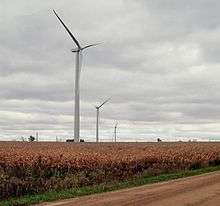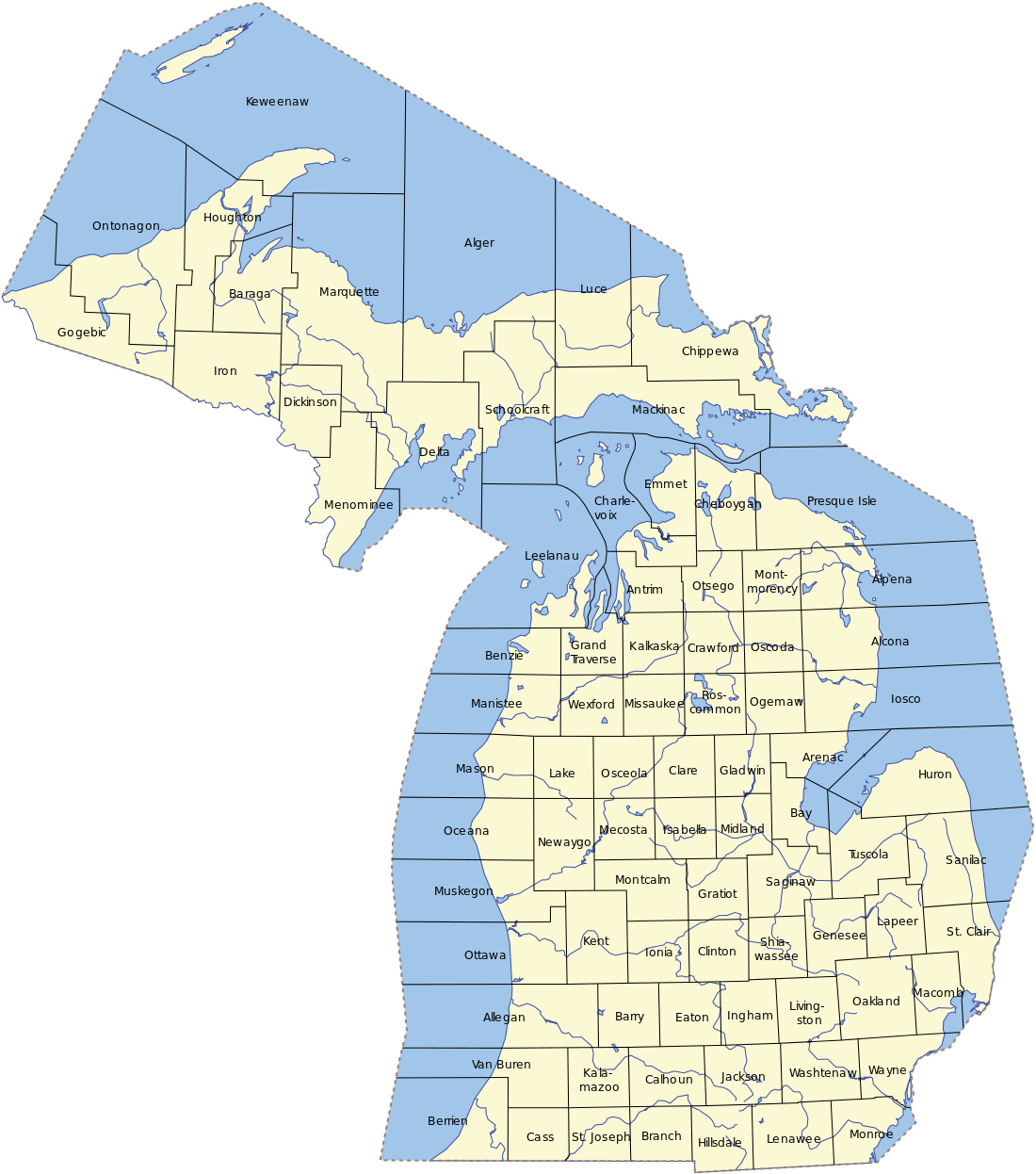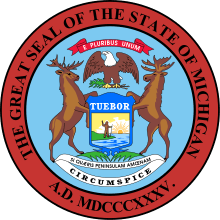The Thumb
The Thumb is a region and a peninsula of the U.S. state of Michigan, so named because the Lower Peninsula is shaped like a mitten. The Thumb area is generally considered to be in the Central Michigan region, located east of the Tri-Cities, and north of Metro Detroit. The region is also branded as the Blue Water Area of Michigan.
| The Thumb | |
|---|---|
 | |
| Location | Michigan, United States |
| Coordinates | 43.6°N 83.0°W |
The counties which constitute the Thumb are those forming the extended peninsula that stretches northward into Lake Huron and Saginaw Bay. There is no formal declaration for which of these counties are part of the Thumb. Virtually all definitions of The Thumb include Huron, Tuscola, and Sanilac counties, and most common definitions are extended to include Lapeer and St. Clair counties as well.
Economy
The Thumb region is very flat with fertile soil, the reason for its historical role as a chiefly agricultural area. Major agricultural products include sugar beets, navy beans,[1] corn, fruits, and fish from the Saginaw Bay and Lake Huron. Manufacturing – particularly concerning the Automotive Industry – is also prevalent in Michigan's Thumb. Many different types of industries can be found in the thumb, mostly located in the southern portion of the region near the larger metropolitan areas of Detroit and Flint.
Industry

The Thumb has many notable businesses, many linked to agriculture.
- Intertape Polymer Group, Inc. has a major factory in Marysville.
- Cargill Salt operates a large salt mine and factory in St. Clair. This is the only plant in the U.S.A. that produces Alberger salt, which is especially prized in the fast food industry because of its higher volume (due to its unique shape) and lower sodium content (for a given volume, not weight). This is part of Michigan's large salt-mining industry.
- Cooperative Elevator Company has been named the top Michigan Agriculture Exporter by the Michigan Department of Agriculture.[2] Its headquarters are in Pigeon, and it has branch elevators in Deckerville, Akron, Gagetown, Sebewaing, Elkton, and Bad Axe.
- Detroit Edison is the operator of three power plants in the Thumb area: St. Clair and Belle River Power Plants in East China Township, and Greenwood Energy Center in Greenwood Township.
- Dow AgroSciences Harbor Beach manufactures agricultural chemicals: weed killer, fungicides, fertilizers and plant nutrients and herbicides.[3]
- Mueller Industries owns and operates Mueller Brass in Port Huron.[4]
- Grand Trunk Western Railway has a major rail yard in Port Huron Township.
- Marysville Hydrocarbons is an ethanol plant in Marysville.
- Michigan Ethanol, a partner of Broin Companies, operates a corn ethanol production facility in southwest Caro.
- Michigan Sugar Company, an agricultural cooperative owned by 1200 farmers, operates four plants in the area. It is the successor to the 100-year-old "Big Chief" and "Pioneer" Sugar companies.[5] Local plants are located in Caro, Sebewaing, Croswell, and headquarters in Bay City.
- Domtar operates a paper mill in Port Huron.
- Keihin Michigan Manufacturing operates an auto part manufacturing plant in Capac, they build HVAC and intake manifold assemblies that are used in Honda vehicles.[6]
- Sensient Technologies Corporation, Harbor Beach, makes food flavors and colors, yeast dehydrated products and vegetable protein extract.[7]
- Star of the West Milling Co.[8] which has grain elevators in Vassar and Cass City, joined with Eastern Michigan Grain in Emmett.[9]
- Huron Castings[10] produces shell molded steel castings in Pigeon, Michigan.
- Pigeon Telephone Co. has been meeting telecommunications needs of the rural communities it serves since 1908.[11]
- Agri-Valley Services,[12] more commonly known as AVCI, is an internet service provider based out of Pigeon, Michigan.
- Thumb Cellular has been providing rural cellular service to the thumb area since 1991.[13]
International Trade Corridor
The I-69 International Trade Corridor is a strategic commercial gateway between the Midwestern United States and Ontario, Canada, with multi-modal transportation infrastructure that offers a wide range of distribution options. The I-69 International Trade Corridor Next Michigan Development Corporation (NMDC) offers economic incentives to growing businesses, both existing and new, that utilize two or more forms of transportation to move their products and are located within the territory of the NMDC. The I-69 International Trade Corridor Next Michigan Development Corporation is the largest in the state of Michigan with 35 municipal partners.[14]
Constituent counties of the trade corridor are: Shiawassee, Genesee, Lapeer, and St. Clair Counties.[15]
Tourism

Some towns, such as Bay Port, Caseville, Harbor Beach, Lakeport, Lexington, Port Austin, Port Hope, Port Huron, Port Sanilac, Sebewaing, and St. Clair enjoy seasonal tourism, due to their locations on Lake Huron, Saginaw Bay, or St. Clair River. Tourism and farming drive the local economy.
The Tip of The Thumb Heritage Water Trail is a nonprofit citizens organization working with the Huron County Parks to establish and maintain a water trail along Michigan's Lake Huron's shoreline.[16]
Unique to the Thumb
Many of the residents commute for work to Metro Detroit, Flint or the Tri-Cities. Incorporated cities with 2,000+ population in the Thumb area are Port Huron, Marysville, Lapeer, St. Clair, Marine City, Algonac, Caro, Imlay City, Bad Axe, Vassar, Sandusky and Croswell. The majority of these cities are in the southern portion of the Thumb.
Unique features in the area include the following:
- Algonac, known as the Venice of Michigan because of its many canals, is a part of the largest freshwater delta in the world, that of the St. Clair River into Lake St. Clair.
- Bad Axe was named after a broken axe found lodged in the knot of a tree at the clearing of the settlement's chief crossroads.[17]
- Bay Port, is the world's largest freshwater fishing port.
- Harbor Beach is the home of the largest man-made harbor and the Harbor Beach Light.
- Harvest Wind Farm, an electrical generation project of Exelon Wind and Wolverine Power Supply Cooperative. Harvest II is scheduled for completion in December 2012.
- Huron County Nature Center includes a 120-acre (0.49 km2) wilderness arboretum that has been under the care of the Huron County Women's Clubs for more than 50 years.[18]
- Kernan Memorial Nature Sanctuary is a 45-acre (180,000 m2) refuge with 4,000 feet (1,200 m) of shoreline acquired October 30, 1989 on Lake Huron, in Huron County. On the western coast of Whiskey Harbor, this area is a great place to see migratory birds in early March and November.[19]
- Kinde was once the bean capital of the world. Michigan Bean soup has been a staple for over a hundred years in the U.S. Senate dining room (Senate bean soup).[20]
- Pigeon is the home of the Cooperative Elevator Company, one of the largest grain elevators in the state.
- Port Huron is the maritime capital of the Great Lakes, where Lake Huron flows into the St. Clair River. This is the largest city in the Thumb area. It was the boyhood home of Thomas Edison.
- The Sanilac Petroglyphs were discovered after massive fires swept the Lower Peninsula in 1881. Native Americans created this unusual artwork 300 to 1,000 years ago. The petroglyphs provide a glimpse into the lives of an ancient woodland people who occupied Michigan's Thumb area.
- Sebewaing is the sugar beet capital of the world, and home to one of the four Michigan Sugar Company factories in the Thumb region. The sugar companies were organized with money from lumber barons such as Rasmus Hanson.[21]
- St. Clair boasts the world's largest boardwalk along freshwater, the St. Clair River.
- Turnip Rock, an unusual undercut sea stack at the extreme northern tip of the Thumb.
- Michigan Underwater Preserves are protected areas of the Great Lakes on Michigan's coast. There are nineteen major shipwrecks in the 276 square miles (710 km2) of the Thumb Area Bottomland Preserve and the Sanilac Shores Underwater Preserve which expands a total of 163 square miles (420 km2) of Lake Huron.
- Caseville is the home of the annual Cheeseburger in Caseville festival, a hometown festival devoted to Jimmy Buffett's song "Cheeseburger in Paradise".
Traveling around the Thumb
A favorite of tourists who visit this area is traveling the Lake Huron and Saginaw Bay shoreline via M-25 (formerly US Highway 25 until 1973). M-25 starts at the end of I-69/I-94 in Port Huron at the foot of the Blue Water Bridge and ends in Bay City. The whole highway is about 150 miles (240 km), and passes through quaint cities and villages. Located along Lake Huron through which M-25 passes are five lighthouses: Fort Gratiot Lighthouse, Port Sanilac lighthouse, Pointe aux Barques Lighthouse, Harbor Beach Light, and the Port Austin Lighthouse.
The Great Lakes Circle Tour is a designated scenic road system connecting all of the Great Lakes and the St. Lawrence River.[22] Many visitors choose to begin the circle tour in Port Huron, from which they can circle Lake Huron. M-25 winds around the Thumb and along the Saginaw Bay to Saginaw and Bay City. Lexington and Port Austin feature beaches and boardwalks that are favorites with visitors.
Lighthouse Tour
.jpg)
In order from east to west:
- Huron Lightship — Lake Huron / St. Clair River — Port Huron
- Fort Gratiot Light—Lake Huron / St. Clair River—Port Huron
- Port Sanilac Light—Lake Huron— Port Sanilac—Private
- White Rock Memorial Light—Lake Huron — White Rock—Private
- Harbor Beach Light—Lake Huron — Harbor Beach
- Pointe aux Barques Light—Lake Huron—near Port Hope
- Port Austin Light—Lake Huron — Port Austin
- Charity Island Light — Saginaw Bay
- Saginaw River Light — Saginaw River
Area festivals and events
- Antique and Yard Sale Trail 2nd weekend in August, (Algonac to Sebewaing)
- Art on the River, third week in June, St. Clair.
- Art on the Avenue, downtown Port Huron, 3rd week in August.
- "Arts and Crafts shows calendar". Archived from the original on 2008-01-20. around the state.
- Bay Port Fish Sandwich Festival (Bay Port)
- Blue Water Ramble (St. Clair) Annual International Bicycling Event along the St. Clair River in Michigan and Ontario, Canada, involving two ferry boat crossings, first weekend in October.[23]
- Boat Night[24] & Port Huron to Mackinac Boat Race[25] (Port Huron to Mackinac Island)[26]
- Cheeseburger in Caseville Festival (Caseville)[27][28]
- Croswell Agricultural Society Fair (Croswell) celebrating its 125th year in 2009
- Croswell Swinging Bridge Festival (Croswell)
- Feast of the Sainte Claire sponsored by the Port Huron Museum of Arts and History, a large living reenactment of 18th century life—Memorial Day weekend, (Port Huron).
- Harbor Beach Maritime Festival(Harbor Beach)
- Huron County Fair (Bad Axe)[29]
- Michigan Bean Festival Labor Day weekend (Fairgrove)
- Farmer's Festival[30] (Pigeon)
- Michigan Sugar Festival (Sebewaing)
- "Port Huron Float Down" Third Sunday in August (Port Huron)
- "The Original" Country Christmas Lighted Farm Implement Parade (Sandusky)
- Tuscola County Pumpkin Festival (Caro)
- Sanilac County 4-H Fair (Sandusky)
- St. Clair County 4-H Fair (Goodells County Park)
- Thumbfest (Lexington)
- Yale Bologna Festival (Yale)
Thumb counties
Huron
Huron County is located at the tip of the thumb. The county is surrounded on three sides by water – Saginaw Bay and Lake Huron, and has over 90 miles (140 km) of shoreline, from White Rock on Lake Huron to Sebewaing on Saginaw Bay, and more shoreline parks than any other county in the state.
The county's economy relies on agriculture and ranks as one of the top agricultural counties in Michigan. Rich farmland inland produces beans, sugar beets and grain, including most of the world's supply of navy beans.[31] Tourism is also important to Huron County with bay front and lakefront towns such as Sebewaing, Caseville, Port Austin, Port Hope, and Harbor Beach, attracting tourists from all over. Huron County borders the Saginaw Bay and Lake Huron. There are two state parks – Sleeper State Park and Port Crescent State Park. Three roadside parks – Jenks Park, Brown Park, and White Rock Park. Also, Huron County maintains nine county parks along the shoreline, which are Caseville Park, Lighthouse Park, Stafford Park, McGraw Park, Philp Park, Port Austin Bird Creek Park, Wagener Park, Oak Beach Park, and Sebewaing Park.
The county seat is Bad Axe, located in the center of the county.
Lapeer
The origin of the name of the county is often disputed, but it may have derived from the French words "la pierre", meaning "the stone." This name could be a reference to the rounded stones, or flint pebbles, found in the rivers and streams throughout the area. Another theory, is that it may simply be an English variation of "Le Pays Plat", meaning "the flat land", which is one of the original names given to the area by the French, and can be found on many early fur trader maps of the area. The idea is that "Le Pays" may have evolved into the current pronunciation, "Lapeer."
Lapeer County is in many ways different from the other counties of The Thumb. First, it is heavily influenced by its proximity to Flint and Detroit, so as a result, its economy depends more heavily on manufacturing, than the other counties of the region. Second, although agriculture is still a key economic factor in Lapeer County, it is just not as important to the economy as in the other counties. Although there are still a few large scale farms located in the county, the numbers are not found to the same extent, and these days, most farming in Lapeer now takes place on smaller, independent farms, which usually supply the local markets only. Lastly, in addition to its economic and agricultural differences, Lapeer County's geography is also very different from the other counties of The Thumb. Its topography is generally gently rolling to quite hilly, and unlike its neighbors, which are flatter, and border on Lake Huron or Lake St. Clair, Lapeer County is landlocked. The County still has hundreds of acres of inland lakes such as Barnes Lake-Miller Lake, Lake Neppessing, The Holloway Reservoir, Big Fish Lake, and Lake Metamora, and several state recreation areas, including the Ortonville Recreation Area and the Metamora-Hadley Recreation Area, which still bring in many campers and tourists.
Sanilac
The County of Sanilac has the largest area of land in The Thumb. Like other counties, Sanilac has fertile and flat land, great for growing crops. Towns like Lexington and Port Sanilac bring in many tourists from the Detroit Area. Sandusky is the county seat and largest city.
St. Clair
St. Clair County has the largest population in The Thumb, and is considered part of the Metro Detroit MSA. Many residents farther north in The Thumb, especially Sanilac County, travel to Port Huron for shopping and work. It is the farthest county to the east in Michigan, and most of the eastern border is the St. Clair River, which separates Michigan from Ontario. For the most part, St. Clair County is flat with an agricultural economy dominating in the north and west; in the 19th century, agriculture and lumbering were important east to the St. Clair River. Sugar beets were cultivated and annual festivals were held at harvest time. In addition, many farms had mixed agriculture. There are steep hills and small canyons near the Black River. Since the mid-20th century, manufacturing had dominated in and around Port Huron.
Tuscola
Like Huron County, Tuscola is mostly dependent on agriculture. Industries such as sugar refining and ethanol processing, as well as growing various grains and beans, make up most of the economy. Caro, one of the largest cities in The Thumb (the largest if you exclude St. Clair and Lapeer Counties), is named after Cairo, Egypt and is the county seat. Tuscola County only has 18 miles (29 km) of shoreline along Saginaw Bay, so it is not as dependent on tourism as the other counties in the area. Tuscola County is economically tied to the surrounding region as well as to the Saginaw, Bay City, and Flint areas.
Borderline regions
The boundaries of what is included in the Thumb are often debated, but nearly all definitions include Huron, Sanilac, and Tuscola counties, known as the tri-county region. Disputed areas include:
- St. Clair County, especially the southern portion, as the county is now classified as part of Metro Detroit by the Census Bureau.
- Lapeer County
- Richmond and northern Macomb County.
- Genesee County, although it is more urbanized, is still often considered part of the Thumb peninsula.
Blue Water Area
The Blue Water Area is another term describing the Thumb of Michigan. The term usually applies to St. Clair County and surrounding areas. The title is also extended to include all of Michigan's Thumb. The name refers to the county being bordered by water: on the east is the St. Clair River, connecting Lake Huron to the north to Lake St. Clair. Below that is the Detroit River. The namesake Blue Water Bridge spans the St. Clair river, connecting Port Huron to Sarnia, Ontario. A similar name, "Blue Water Country," is used to describe the same region on the Canadian side.
Discover the Blue
Discover the Blue is a promotion by the Blue Water Area Convention and Visitor's Bureau.[32] It is designed to attract visitors to the shoreline of eastern Michigan. Communities participating in Discover the Blue include Algonac in St. Clair County (at the southern end of the Thumb) and others to the north, such as Port Austin (at the tip of the Thumb).
Geography
Land features
See also List of Michigan state parks and geography of Michigan.
- The Thumb's landscape ranges from a flat sandy plain along the shores of Lake Huron and Saginaw Bay, to a gently rolling topography. This land is fertile and well suited for agriculture. The most unusual geographic formation is a rugged glacial ridge, known collectively as the Hadley Hills, which extends in a northeasterly direction through the center of The Thumb, from the southwestern portion of the peninsula.
- All counties except for Lapeer border the Saginaw Bay or Lake Huron.
- The places with the highest elevation are all associated with the Hadley Hills, and are located in Lapeer County, they are: Pinnacle Point, at 1,262 feet (385 m), Kerr (Cemetery) Hill, at 1,258 feet (383 m), both in Hadley Township, Mt Christie, at 1,251 feet (381 m), in Metamora Township, and a point near Mayville, reaching up to 1,050 feet (320 m) above sea level.
- The lowest point in the Thumb region is the shore of Lake St. Clair, at a low of 574 feet (175 m) above sea level.
- Huron County is very flat. It has large fields that were used for agriculture and now are the sites of numerous wind turbines to generate electricity.
- The "tip of the Thumb" is Pointe Aux Barques, between Port Austin and Grindstone City.
- Marlette is called the "heart of the Thumb," because of its central position on the peninsula.
Major rivers
The Thumb has many waterways.
- Cass River has many branches, one of which flows into the Shiawassee River in the Shiawassee National Wildlife Refuge at 43°22′42″N 83°59′04″W less than 1 mile (2 km) from where the Shiawassee merges with the Tittabawassee River to form the Saginaw River
- The Pinnebog, Shebahyonk, and Pigeon rivers all rise in the center of Huron County and empty into the Saginaw Bay.
- St. Clair River, connects Lake Huron to Lake St. Clair, and is the farthest east border in Michigan. It forms a low impression in eastern St. Clair County, and has a delta at its mouth (North America's largest freshwater delta), which includes Harsens Island and Walpole Island, Ontario. Ferries cross the river at Algonac and Marine City, these being international border crossings.
- Black River rises near Minden City and flows into the St. Clair River at Port Huron. The Black River forms a basin in Sanilac County, and northern St. Clair County.
- The north branch of the Flint River lies in northern Lapeer County. It rises near North Branch. The southern branch flows through the central and southern portion of Lapeer County, originates in Brandon, Atlas, Hadley, and Metamora townships before merging with the North Branch just north of the Holloway Reservoir.
History and local culture
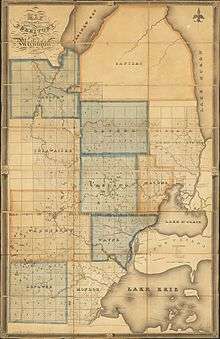
Culture
Since the late 18th century, ethnic European Americans have displaced the Native American tribes that historically occupied this territory. Since the early 20th century, they have dominated the population and culture of The Thumb. The French were the first Europeans to arrive, and thus influenced much of the early culture. They were mostly engaged in the fur trading and lumber industries, and had relatively few settlers. After the British won the French and Indian War, they took over this former French territory.
Many of these new settlers were sent into the area by the British from Canada in an effort to establish their dominance over the Great Lakes. In 1783, control of The Thumb was officially transferred to the newly formed United States, after the American Revolution and by the Treaty of Paris. The British were a dominant influence until after the War of 1812, when the northern border was firmly defined and this area came under US control. The US organized the Northwest Territory, and American settlement of Michigan and The Thumb was well underway by the mid-19th century. Construction of the Erie Canal through Central New York created stronger connections with the port of New York and eastern markets. Settlers migrated west from New York and New England into Ohio and Michigan, seeking new territory.
As a result of this history, the land was settled primarily by people of ethnic English and Scots-Irish descent; many arrived from Canada. Other settlers of the same ancestry migrated from eastern states such as New York, and Pennsylvania, as well as from New England. Immigration from the British Isles took place through the century, and later 19th and 20th century residents included Polish and German immigrants who migrated from Europe through the Detroit area. Many of the customs, much of the regional lifestyle, and even the local accent, strongly reflect these origins. Some local radio stations have featured polka shows, and various ethnic festivals, such as the Polkafest, in Kinde, are representative of Eastern European cultures.
In the early years, Europeans encountered and traded with people of the Fox and Sauk tribes, already living in the area for centuries. There may have also been other tribes in the area such as the Potawatomi, Ojibwe, and Kickapoo, but they would have been transient tribes, or found in very small numbers. All native Thumb area tribes are members of the Algonquian peoples, a large language family. Other tribes who migrated later into the area included the Wyandot (Huron), an Iroquoian language-speaking people; and the Ottawa. The displacement of native peoples took place in many areas during the settling of North America.
Historical events
- The Port Huron area is one of oldest European settlements in the state of Michigan, first settled by French colonists.
- Colonial-era forts such as Fort Gratiot (north of Port Huron) and Fort Sinclair (near present-day St. Clair) were built along the St. Clair River.
- Bad Axe was named so because Captain Rudolph Papst found an old axe in 1861, when he was clearing land for the present-day Huron County seat.
- The great Thumb Fire took place on September 5, 1881 in the Thumb area of Michigan. The fire, which burned over a million acres (4,000 km²) in less than a day, was the consequence of drought, hurricane-force winds, heat, the after-effects of the Port Huron Fire of 1871, and the ecological damage wrought by the era's logging techniques of clear cutting forests.
- The Great Lakes Storm of 1913 was a November blizzard with hurricane-force winds; it devastated the Great Lakes Basin in the United States Midwest and the Canadian province of Ontario. The storm also battered and overturned large ships on four of the five Great Lakes, particularly Lake Huron.
Notable people (by town)
More comprehensive lists are available at individual cities, villages, etc. See local towns of interest at the bottom of the page for links.
Brown City
- Robert Teet – Wrestler, author
Cass City
- Brewster H. Shaw – retired United States Air Force colonel and former NASA astronaut.
Deckerville
- Gabriel Rheaume – Writer – The Shores We Walk
Harbor Beach
- Frank Murphy – Detroit mayor, Michigan governor, U.S. Attorney General and Justice of the United States Supreme Court.
Lapeer
- Marguerite de Angeli, children's book author, Newbery Award winner
- Danelle Gay, Miss Michigan USA 2006
- Terry Knight, singer, DJ, manager, Terry Knight and the Pack, Grand Funk Railroad
- Jake Long, offensive lineman, Miami Dolphins
- Terry Nichols, accomplice in the Oklahoma City bombing
- Jim Slater, hockey player Atlanta Thrashers
Port Huron
- Thomas Edison – Inventor and entrepreneur settled in Port Huron from 1854 to 1863.
- Obadiah Gardner – born in Port Huron, he moved to Maine as a child, where he lived and worked for the rest of his life, being elected as US Senator from Maine
- Terry McMillan – Award-winning author of novels Waiting to Exhale, and How Stella Got Her Groove Back
Local elected officials
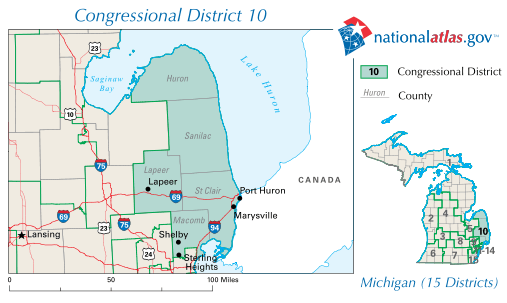
Local politicians in Washington and Lansing are listed below.
United States Congress
District 10 – Northern Macomb, and all of St Clair, Lapeer, Sanilac, and Huron County.
District 5 – Saginaw/Bay City Area, and all of Genesse and Tuscola.
- Dale E. Kildee, Democrat
Michigan House
32nd District – Northern Macomb and six townships in St Clair County.
- Andrea LaFontaine, Republican
81st District – Most of St Clair County, except Port Huron.
- Dan Lauwers, – Republican
82nd District – All of Lapeer County.
- John Stahl, Republican
83rd District – City of Port Huron, Fort Gratiot, and all of Sanilac County.
- Shane Hernandez, Republican
84th District – Huron and Tuscola County.
- Terry Brown, Democrat
Michigan Senate
25th District – St. Clair and Lapeer Counties.
- Phil Pavlov, Republican
Colleges and universities
- St. Clair County Community College, with the main campus in Port Huron, and learning centers in Huron, Sanilac, and Lapeer Counties.
- Baker College, with a campus in Cass City, Sandusky, and Port Huron.
- University of Michigan–Flint, Saginaw Valley State University, and Delta College, while not in the Thumb, are universities and colleges that attract many residents from the Thumb.
Museums
Harbor Beach
- Frank Murphy Memorial Museum and home.[33]
- Grice House Museum – Harbor Beach[34]
Marysville
- Marysville Historical Museum – Marysville
- Wills Ste. Claire Auto Museum – Marysville
Port Huron
.jpg)
- Port Huron Museum – a series of five museums – Port Huron[35]
- Carnegie Center – Port Huron
- Huron Lightship – Port Huron
- Thomas Edison Depot Museum – Port Huron
- USCGC Bramble (WLB-392) – Port Huron
- Fort Gratiot Lighthouse – Port Huron
Elsewhere in the Thumb
- Sanilac County Historical Museum – Port Sanilac
- Bad Axe Historical Society Museum – Bad Axe
- Capac Historical Museum – Capac
- Pointe aux Barques Lighthouse near Port Hope
- St. Clair County Farm Museum – Goodells
- Port Austin History Center - Port Austin
Media
Radio
The Thumb Area Radio Region is an unranked market that is influenced by Detroit Radio Market, the Tri-Cities Radio Market and the Flint Market, with stations in Port Huron and Sarnia, Ontario also serving the region.
- Local Radio Stations in the Thumb Area
Newspapers
- The Huron Daily Tribune[36] is a daily newspaper serving the "Upper Thumb Area of Michigan", which includes all of Huron and portions of Tuscola counties.
- The Times Herald[37] is a daily newspaper headquartered in Port Huron and distributed in St. Clair and Sanilac counties. It is owned by the Gannett Company.
- Daily editions of the Detroit Free Press and The Detroit News are available throughout the area.
- The Bay City Times[38] and Saginaw News[39] are available in northern and western portions of the area, while the Flint Journal is available in Lapeer County.
- Huron County newspapers
- Harbor Beach Times
- Huron County Press
- Huron Daily Tribune[36]
- The News Weekly
- The Lakeshore Guardian
- Thumb Blanket
- Lapeer County newspapers
- Buyer's Guide
- The County Press[40]
- LA View
- Webco Press
- Sanilac County newspapers
- Brown City Banner
- Buyers Guide
- Camden Publications
- Deckerville Recorder
- Marlette Leader
- Sandusky Tribune
- Sanilac County News[41]
- St. Clair County newspapers
- Blue Water Shopper
- Port Huron Times Herald[37]
- The Thumb Print News
- The Voice
- The Yale Expositor
- Tuscola County Newspapers
- Tuscola County Advertiser[42]
- Cass City Chronicle
- Cass River Trader
- Reese Reporter
- Vassar Pioneer Times
- Mayville Monitor
Broadcast television
The Lapeer County, St. Clair County and Sanilac County area lies in the Detroit Television Market. The far northern and western areas lie inside the Flint/Tri-Cities Television Market. The only broadcast TV station licensed to the Thumb region is WDCQ-TV, the PBS station licensed to Bad Axe.
- Flint/Tri-Cities
- Sarnia/Windsor Ontario
- Detroit area
- Alpena area
- WBKB-TV, CBS / ABC / Fox / MyTV 11
Transportation
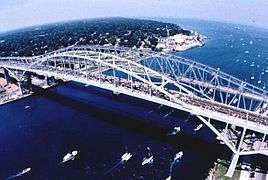
Borders
The border between Port Huron, Michigan and Sarnia, Ontario is one of the busiest connections between Canada and the US. Crossings include the two Blue Water Bridges and the two St. Clair River Railway Tunnels. Ferries also connect to Canada at Marine City and Algonac.
Major highways
(organized by numbers)














Rail
Area Amtrak stations are in Lapeer, Port Huron, and Flint. Local railroads are the Grand Trunk Western Railroad, CSX Transportation, Canadian National Railway, and the Huron and Eastern Railway. Pere Marquette Railway was a railroad that had lines throughout the Thumb; its lines are now either abandoned or in use by CSX, or Huron and Eastern.
Major railroad centers are Vassar, Bad Axe and Port Huron.
Airports
The only international airport in the Thumb is St. Clair County International Airport about 6 miles (9.7 km) outside Port Huron. City airports include: Caro Municipal, Dupont-Lapeer Airport, Huron County Memorial Airport, Marine City Airport, Marlette Municipal, Sandusky City, and Yale Airport. Scheduled airline service is available from MBS International Airport[44] in Freeland, Michigan and Flint Bishop International Airport.[45] While neither of these airports is in the Thumb, both are relatively close by.
Area codes
Area code 989 covers about half of the Thumb: Huron, Tuscola, and far northern Sanilac County (and the Marlette, Michigan area). The Thumb's other half is covered by area code 810, which takes in most of Sanilac, Lapeer, Genesee and Saint Clair Counties. All of Macomb County is served by area code 586, as is a small part of south-western Saint Clair County.
See also
State
Regional
Counties
Cities and villages
- Akron (Tuscola)
- Algonac (St. Clair)
- Applegate (Sanilac)
- Almont (Lapeer)
- Armada (Macomb)
- Bad Axe (Huron)
- Brown City (Sanilac/Lapeer)
- Capac (St. Clair)
- Caro (Tuscola)
- Carsonville (Sanilac)
- Caseville (Huron)
- Cass City (Tuscola)
- Clifford (Lapeer)
- Columbiaville (Lapeer)
- Croswell (Sanilac)
- Deckerville (Sanilac)
- Dryden (Lapeer)
- Elkton (Huron)
- Emmett (St. Clair)
- Fairgrove (Tuscola)
- Forestville (Sanilac)
- Gagetown (Tuscola)
- Harbor Beach (Huron)
- Imlay City (Lapeer)
- Kinde (Huron)
- Kingston (Tuscola)
- Lapeer (Lapeer)
- Lexington (Sanilac)
- Marine City (St. Clair)
- Marlette (Sanilac)
- Marysville (St. Clair)
- Mayville (Tuscola)
- Melvin (Sanilac)
- Memphis (St. Clair/Macomb)
- Metamora (Lapeer)
- Millington (Tuscola)
- Minden City (Sanilac)
- North Branch (Lapeer)
- Otter Lake (Lapeer/Genesee)
- Owendale (Huron)
- Peck (Sanilac)
- Pigeon (Huron)
- Port Austin (Huron)
- Port Hope (Huron)
- Port Huron (St. Clair)
- Port Sanilac (Sanilac)
- Reese (Tuscola/Saginaw)
- Richmond (Macomb/St. Clair)
- Romeo (Macomb)
- Sandusky (Sanilac)
- Sebewaing (Huron)
- St. Clair (St. Clair)
- Ubly (Huron)
- Unionville (Tuscola)
- Vassar (Tuscola)
- Yale (St. Clair)
Notes
- Saginaw Valley Dry Bean and Sugar Beet Research Farm, Archived 2009-03-28 at the Wayback Machine Michigan State University.
- "Co-Op Elevator Co". Archived from the original on 2007-12-01. Retrieved 2008-02-07.
- "Macraes Blue Book".
- "Mueller Industries".
- "Michigan Sugar Company".
- "About Keihin Michigan Manufacturing". Archived from the original on 2011-08-14. Retrieved 17 January 2012.
- "Macraes Blue Book".
- "Star of the West Milling Co". Archived from the original on 2007-10-07. Retrieved 2008-02-07.
- "Eastern Michigan Grain".
- "Huron Castings".
- "Pigeon Telephone Company".
- "AVCI".
- "Thumb Cellular".
- Next Michigan Development Corporation
- http://i-69internationaltradecorridor.com/about/ International Trade Corridor
- Tip of The Thumb Heritage Water Trail
- "Bad Axe Historical Society, origin of Bad Axe's name".
- "The Huron County Nature Center". Huron Nature Center.
- "Kernan Memorial Nature Sanctuary".
- Michigan Bean Soup recipe and history, the Honorable and Mrs. John D. Rockefeller IV, U.S. Senator.
- "Rasmus Hanson biography". Archived from the original on 2009-01-07.
- "Great Lakes Circle Tour". Archived from the original on 2010-07-25.
- "Blue Water Ramble/Clinton River Riders".
- "Port Huron to Mackinaw Island Sailboat Race – Family Night". Flickr – Photo Sharing!.
- "Port Huron to Mackinac Island, Michigan Yacht Race". byc.com. Archived from the original on 2009-04-10. Retrieved 2009-03-29.
- Morris, Julie The Port Huron to Mackinac race, May 1, 2001 Detroit News
- Cheesburger in Caseville at Archived 2012-03-14 at the Wayback Machine Pure Michigan.
- Campbell, Ron. August 13, 2010 Cheeseburger in Caseville festival turns town into 'Fun, wacky, tasteful and tacky' place Archived March 14, 2012, at the Wayback Machine Bay City Times.
- hostmaster (10 October 2016). "Welcome To Pure Michigan". Michigan. Archived from the original on 25 January 2017.
- "Farmer's Festival". Archived from the original on 2011-08-28. Retrieved 2011-12-29.
- "Michigan Bean Commission". michiganbean.org. Archived from the original on 2009-03-28. Retrieved 2009-03-29.
- "Blue Water Area Convention and Visitor's Bureau".
- "Harbor Beach attractions". Archived from the original on 2008-01-14.
- Harbor Beach, Yesterday and Today, Compiled by the Harbor Beach Woman's Club. First Printing 1976, Revised Edition 1996.
- "Port Huron Museum".
- Huron Daily Tribune. "michigansthumb.com". Huron Daily Tribune.
- "Port Huron – Home". The Times Herald.
- "Bay City Times".
- "Saginaw News".
- "Front Page – February 3, 2016 – thecountypress.mihomepaper.com – The County Press".
- "Front Page – February 3, 2016 – sanilaccountynews.mihomepaper.com – The Sanilac County News".
- "Tuscola County Advertiser – Serving Eastern Michigan since 1868Tuscola County Advertiser – Serving Eastern Michigan since 1868 – Tuscola County Advertiser – Serving Eastern Michigan since 1868". Tuscola County Advertiser – Serving Eastern Michigan since 1868.
- Garnell, Dan. "M-46". Michigan Highway Ends. Archived from the original on 2005-04-14.
- "MBS International Airport".
- "Flint Bishop International Airport".
Further reading
- Ackerman, Emma J. Thumb Fires of 1871 and 1881. CMU Term Paper, 1968.
- DuMond, Neva. Thumb diggings; adventures into Michigan's Thumb area. Lexington, Mich, 1962.
- The Great Fire of 1881: A Collection of Stories. Caro, MI: Tuscola County Advertiser, 1981.
- Hatt, R. T. — The petroglyphs, by D. J. Richards. — An archeological survey of the petroglyph site, by M. Papworth (republished from the Michigan archeologist, Dec. 1957) The Sanilac petroglyphs. Bloomfield Hills, Michigan: Cranbrook Institute of Science, 1958
- House Party: Reminiscences by Traditional Musicians and Square Dance Callers in Michigan's Thumb Area. Port Huron, MI: Museum of Arts and History, 1982.
- Schultz, Gerard. A History of Michigan's Thumb.
- Smith, Dee. Treks into the Past: Historical Sketches of Michigan's Thumb. Decatur, MI: Heritage Valley Publishing, 1989.
- Southgate, Jerry D. Thumb's Forest Fire of 1881. Central Michigan University Term Paper, 1967.
External links
| Wikimedia Commons has media related to The Thumb. |
